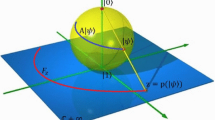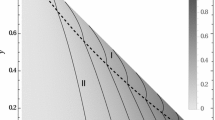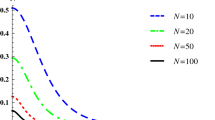Abstract
In this paper, we first generalize the previous results that relate 1- and 2-qubit geometries to complex and quaternionic Möbius transformations respectively, to the case of 3-qubit states under octonionic Möbius transformations. This completes the correspondence between the qubit geometries and the four normed division algebras. Thereby, new systems of symmetric coherent states with 2 and 3 qubits can be constructed by mapping the spin coherent states to their antipodal symmetric ponits on the generalized Bloch spheres via Möbius transformations in corresponding dimensions. Finally, potential applications of the normed division algebras in physics are discussed.
Similar content being viewed by others
Notes
Note that when there are more than one qubits, the ”geometry” is not simply the geometry of the state space, but the geometry of the state space quotiented by the global phases which are not reflected in the fibres.
The reason is that the Möbius transformations in \(\mathbb {R}^{n+1}\) (\(n\geqslant 2\)) can be described by the real Clifford algebra \(\mathbb {R}_{0,n+1}\) with α,β,γ,δ,∈Γ(n+1)∪{0} where Γ(n+1) is the Clifford group, while in \(\mathbb {R}^{8}\) the Clifford algebra \(\mathbb {R}_{0,8}\) has an octonionic representation[11] in which the representation matrix with octonionic components, just as the G given above, transforms the basis of the carrier space to the primed one. In this representation, the carrier space is just the set of octobits or the octonionic spinor space \(\mathbb {O}\otimes \mathbb {O}\). Hence, given the local transformations g’s, one can find the corresponding octonionic matrix representation G acting on the octonionic spinors such that all umprimed basis elements of the spinors are transformed to the primed ones that are originally obtained by the g’s.
Two points x,x ∗ are symmetric if their cross-ratios satisfy \((x^{*},x_{1},x_{2},x_{3})=\overline {(x,x_{1},x_{2},x_{3})}\). Hereafter ∗ denotes the symmetric point and a bar denotes involution.
Beside the standard Bell transform, as has been explored in [14], there are other types of Bell transforms. One can apply the Yang-Baxter gate as a Bell transform to the coherent basis to generate spin coherent states for some integrable models, the existence of which is of course still an open problem.
The readers who are uncomfortable with these mathematical complications can jump to propsition 4.4., since the procedure to find the antipodal point is similar to that in the 1-qubit case.
References
Baez, J.C.: The octonions. Bull. (New Ser.) Amer. Math. Soc. 39, 145 (2002)
Bott, R., Milnor, J.: On the parallelizability of the spheres. Bull. Amer. Math. Soc. 64, 87 (1958)
Steenrod, N.: The Topology of Fibre Bundles. Princeton University Press, Princeton (1951)
Mosseri, R., Dandoloff, R.: Geometry of entangled states, Bloch spheres and Hopf fibration. J. Phys. A: Math. Gen. 34, 10243 (2001)
Bernevig, B.A., Chen, H.-D.: Geometry of the three-qubit state, entanglement and division algebra. J. Phys. A: Math. Gen. 36, 8325 (2003)
Lee, J., Kim, C.H., Lee, E.K., Kim, J., Lee, S.: Qubit geometry and conformal mapping. Quantum Inf. Process. 1, 129 (2002)
Najarbashi, G., Ahadpour, S., Fasihi, M.A., Tavakoli, Y.: Geometry of a two-qubit state and intertwining quaternionic conformal mapping under local unitary transformations. J. Phys. A: Math. Theor. 40, 6481 (2007)
Najarbashi, G., Seifi, B., Mirzaei, S.: Two and three-qubits geometry, quaternionic and octonionic conformal maps, and intertwining stereographic projection. arXiv:1501.06013v2
Dür, W., Vidal, G., Cirac, J.I.: Three qubits can be entangled in two inequivalent ways. Phys. Rev. A 62, 062314 (2000)
Manogue, C.A., Dray, T.: Octonionic Möbius transformations. Mod. Phys. Lett. A 14, 1243 (1999)
Schray, J., Manogue, C.A.: Octonionic representations of Clifford algebras and triality. Found. Phys. 26, 17 (1996)
Pashaev, O.K., Gurkan, Z.N.: Energy localization in maximally entangled two- and three-qubit phase space. New J. Phys. 14, 063007 (2012)
Perelomov, A.M.: Coherent states for arbitrary lie group. Commun. Math. Phys. 26, 222 (1972)
Zhang, Y., Zhang, K.: Bell transform, teleportation operator and teleportation-based quantum computation. arXiv:1401.7009v3
Zhang, Z.-X.: Möbius transformation and Poisson integral representation for monogenic functions. Acta Math. Sin. (Chin. Ser.) 56, 487 (2013)
Borsten, L., Dahanayake, D., Duff, M.J., Ebrahim, H., Rubens, W.: Black holes, qubits and octonions. Phys. Rep. 471, 113 (2009)
Grossman, B., Kephart, T.W., Stasheff, J.D.: Solutions to Yang-Mills field equations in eight dimensions and the last Hopf map. Commun. Math. Phys. 96, 431 (1984)
Acharyya, N., Chandra, N., Vadya, S.: Quantum entropy for the fuzzy sphere and its monopoles, JHEP11(2014)078
Deutsch, D.: Quantum computational networks. Proc. R. Soc. Lond. A 425, 73 (1989)
DiVincenzo, D.P.: Two-bit gates are universal for quantum computation. Phys. Rev. A 51, 1015 (1995)
Zhang, Y.: Integrable quantum computation. Quantum Inf. Process. 12, 631 (2013)
Vlasov, A.Yu.: Clifford algebras and universal sets of quantum gates. Phys. Rev. A 63, 054302 (2001)
Acknowledgments
The author thanks Zhiqiang Huang and Jin Yao for helpful discussions. This work is supported in part by Shanghai Normal University under the Grant No. A-6001-15-001487.
Author information
Authors and Affiliations
Corresponding author
Rights and permissions
About this article
Cite this article
Guo, XK. Geometry and Symmetric Coherent States of Three Qubits Systems. Int J Theor Phys 55, 2824–2836 (2016). https://doi.org/10.1007/s10773-015-2915-5
Received:
Accepted:
Published:
Issue Date:
DOI: https://doi.org/10.1007/s10773-015-2915-5




